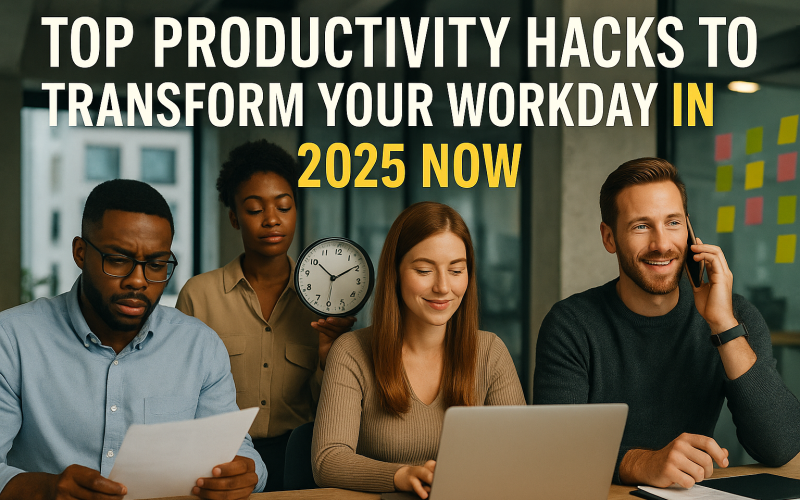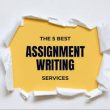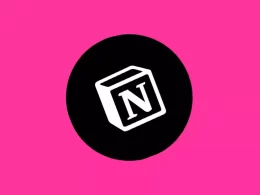Introduction
In 2025, work moves faster than ever. New tools and methods let you do more in less time. If you’re tired of long days and low output, productivity hacks 2025 can help you transform your workday. By using workday productivity tips like time blocking, AI assistants, and deep work sessions, you’ll get focused and finish tasks with ease. This article shows you how to apply proven techniques, adopt healthy daily routines, and choose the easily access right apps to boost your efficiency and improve productivity. Read on to learn simple, actionable hacks that fit into any schedule even when you’re busy.
What Is a Productivity Hack?

A productivity hack is a simple, clever strategy or technique designed to help you work from home more efficiently and get more done in less time. Instead of overhauling your entire routine, a hack targets a specific pain point like minimizing distractions, save time, streamlining repetitive tasks, or organizing your to-do list in a smarter way.
For example, setting a single timer for focused work intervals or batching similar tasks together can dramatically reduce wasted time. By experimenting with small adjustments and tracking their impact, you gradually build a personalized toolkit of shortcuts and routines that boost your output without adding stress or complexity. Over time, these hacks compound into noticeable improvements in both speed and quality of your work.
Top Productivity Hacks For Workday 2025

1. Time-Blocking Method
The time-blocking method means dividing your day into chunks for specific tasks. Instead of a long, unstructured to-do list, you assign tasks to fixed time slots. For example, you might block 9–10 am for email, 10–11:30 am for drafting reports, and 11:30 am–12 pm for breaks or calls.
This approach stops tasks from bleeding into each other. You know exactly when to start and stop. It also boosts focus, because you work without the distraction of shifting gears. Use your calendar app to color-code blocks and set reminders. Review blocks each evening to plan the next day. Time blocking or time tracking is one of the most effective workday productivity tips you can adopt now.
2. The Pomodoro Technique
The Pomodoro Technique is a time management method that uses a timer to break work into intervals, traditionally 25 minutes in length, separated by short breaks. This approach helps maintain focus and prevents burnout. To implement this technique:
- Choose a task you want to work on.
- Set a timer for 25 minutes and work on the task until the timer rings.
- Take a short 5-minute break.
- Repeat the cycle and take a longer break after four sessions.
3. AI Productivity Tools Can Help
AI assistants have come a long way by 2025. They can draft emails, summarize meetings, and even schedule your calendar based on priorities. Tools like AI-driven meeting transcribers and smart inbox assistants filter noise so you see only key messages.
You might use an AI tool that reads documents aloud during your commute, or one that auto-generates social media posts from simple prompts. These AI productivity tools free up hours each week. To start, pick one small task to automate perhaps email sorting and scale up as you grow more comfortable. Within weeks, you’ll notice fewer low-value tasks taking your time.
4. The Power of Deep Work Sessions
Cal Newport’s term “deep work” denotes sustained, distraction-free intervals devoted to intellectually rigorous endeavors. In an era defined by incessant alerts and digital interruptions, the imperative for deep work has never been more pronounced.
To orchestrate a session of deep work, delineate a singular objective—be it drafting a strategic proposal or architecting a complex software module. Allocate a contiguous 60- to 90-minute block in your schedule and eradicate all potential disturbances. Stow your mobile device in a separate location or engage comprehensive “do not disturb” protocols. Employ a reliable chronometer—such as the Pomodoro Technique’s regimen of 25 minutes of unbroken concentration followed by a five-minute respite, iterated four times before indulging in a protracted intermission.
Within these orchestrated intervals, you condition your cognitive faculties to withstand the allure of diversions. With consistent practice, your capacity for sustained attention escalates, enabling you to surmount intricate challenges with greater alacrity. Ultimately, deep work constitutes the foundational pillar of any robust time-blocking strategy.
5. Task Prioritization Strategies
Not all tasks carry equal weight. Effective task prioritization strategies help you decide what truly matters. The classic Eisenhower Matrix divides tasks into four categories: urgent and important, important but not urgent, urgent but not important, and neither urgent nor important.
Focus first on tasks that are both urgent and important critical deadlines. Then schedule time for important but not urgent tasks, such as planning and skill development. Delegate or automate urgent but not important tasks, like routine data entry or meeting scheduling. Finally, eliminate or postpone tasks that are neither urgent nor important.
By applying this matrix each morning or week, you ensure your energy goes to high-impact tasks, rather than busywork. This approach pairs well with time blocking and deep work sessions.
6. Healthy Work Routines for Energy and Focus
Productivity isn’t just about tools; it’s also about your health. Simple healthy work routines boost energy and mental clarity. Start your day with a glass of water and a short stretch to wake up your body.
Schedule brief movement breaks every hour. A quick walk around the office or a few stretches at your desk recharges blood flow and refreshes your mind. Keep healthy snacks—nuts, fruit, yogurt—within reach to avoid energy crashes from sugary treats.
Protect your sleep by setting a consistent bedtime. Aim for seven to nine hours each night, and avoid screens one hour before sleep. Better rest translates to sharper focus during work hours.
7. The Role of Mindfulness and Meditation
Adding mindfulness practices and short meditation sessions can reduce stress and improve concentration. Spend five minutes in the morning on a guided breathing exercise. Focus on inhaling and exhaling deeply, letting go of all thoughts.
During the day, practice quick mindfulness breaks: close your eyes, tune into the sounds around you, or notice the feeling of your feet on the floor. These moments ground you and break the cycle of stress. Over weeks, regular mindfulness sharpens your attention and calms your mind, supercharging all other workday productivity tips.
8. Leveraging Collaboration Tools Efficiently
Collaboration platforms like Slack, Teams, and Asana dominate workplaces in 2025. Use them wisely. Create channels for focused topics project teams, social chats, or bulletins and mute channels that distract during deep work.
Set “office hours” in status messages to let colleagues know when you’re available. Use project boards to track progress visually rather than endless email threads. Assign clear due dates and responsibility owners. Integrate AI chatbots that summarize lengthy discussions into bullet-point updates.
When used thoughtfully, these collaboration tools keep teams aligned without creating chaos. They support asynchronous work and respect individual focus time.
9. Automating Repetitive Tasks with Workflows
Beyond AI, simple automation through workflow tools (Zapier, Make.com, or native integrations) can link apps together. When a form is submitted on your website, automatically create a task in your project management tool, send a templated email, and log it in a spreadsheet.
Automate data backups, social media posts, or invoice generation. Document your processes in flowcharts first, then build automations step by step. Test each flow thoroughly. Gradually, you’ll free dozens of manual hours per month, allowing you to focus on strategic work instead of repetitive chores.
Goal Setting for Success
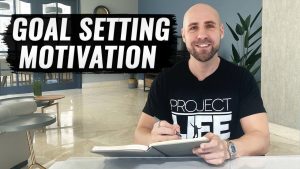
Setting clear, achievable goals is essential for productivity. When you know what you’re working toward, it’s easier to stay focused and motivated.
1.SMART Goals
SMART goals are specific, measurable, achievable, relevant, and time-bound. This framework ensures your goals are clear and reachable.
- Specific: Clearly define your goal.
- Measurable: Set criteria to measure your progress.
- Achievable: Ensure your goal is realistic.
- Relevant: Align the goal with your broader objectives.
- Time-bound: Set a deadline.
2. The 90-Day Goal Framework
Instead of setting long-term goals, break them down into 90-day chunks. This approach can make goals more manageable and provide a sense of urgency, driving you to take action.
- Identify your main goal for the next 90 days.
- Break it down into smaller tasks.
- Review and adjust your plan weekly.
Tips for Sustaining Productivity Long Term
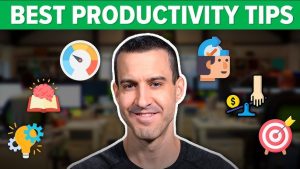
Consistency is vital. Review your routines weekly. Note what works and what feels forced. Adjust time blocks based on shifting priorities and project deadlines. Keep exploring new AI productivity tools but limit to one or two at a time to avoid overload.
Celebrate small wins: finishing a deep work session or automating a new workflow. Share successes with colleagues to inspire them. Take regular vacations or mental health days to recharge. A rested mind stays creative and efficient.
Challenges in Staying Productive
Even the best productivity hacks face real-world hurdles. It can be tough to stick with a new habit when you feel busy or tired. Interruptions like instant messages, unexpected calls, or family needs can pull you off track. Trying to learn too many tricks at once may leave you frustrated instead of focused. It helps to pick one hack and use it for at least a week before adding another. Tracking your progress, even in a simple journal, shows you where you improve or stall. With time and steady effort, you learn which methods fit your day and which ones to drop.
Future of Workday Productivity
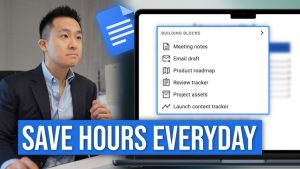
Looking ahead, the line between human habits and smart tools will blur even more. Voice-activated helpers might read out your schedule or trim long emails on command. Wearable devices could track your stress level and suggest a breathing pause when you need it. Personalized dashboards will learn your peak focus hours and block off meetings at the right times. Even simple gadgets like a lamp that dims when it’s time for a break will nudge you toward healthy routines. In the years to come, these blends of habit and tech will shape workdays that adapt to you, helping you stay balanced, creative, and effective.
Comparative Table: Productivity Hacks
| Hack | Time to Implement | Key Benefit | Best For |
|---|---|---|---|
| Time-Blocking Method | 1–2 days | Clear structure, focus | Knowledge work, planning |
| AI Productivity Tools | 1–2 weeks | Automates routine tasks | Email, scheduling, drafting |
| Deep Work Sessions | 1 session | High-quality output, speed | Complex tasks, creativity |
| Task Prioritization (Eisenhower) | 1 session | Focus on impact | Daily planning |
| Healthy Work Routines | 1–2 weeks habit | Sustained energy, mental clarity | All workers |
| Mindfulness & Meditation | 5 minutes/day | Reduced stress, sharper focus | Stressful roles |
| Collaboration Tool Optimization | 1 week | Clear communication, less noise | Teams, remote work |
| Workflow Automations | 2–4 weeks | Saves hours on manual tasks | Ops, admin |
Conclusion
Implementing these productivity hacks 2025 can transform your workday from chaotic to controlled. Use the time-blocking method and deep work sessions to focus, leverage AI productivity tools and simple workflow automations for routine tasks, and maintain healthy work routines for lasting energy. Prioritize wisely with the Eisenhower Matrix, practice mindfulness for calm, and optimize collaboration tools to reduce noise. With consistent effort and smart adoption of these workday productivity tips, you’ll achieve more in less time and scale your impact.






